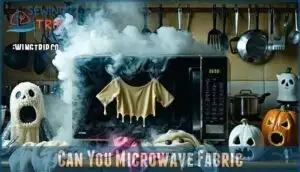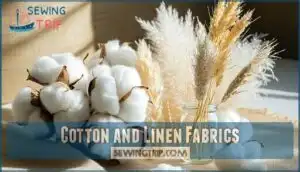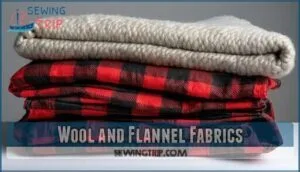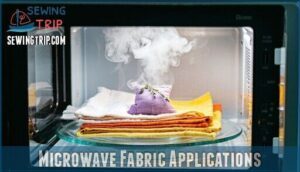This site is supported by our readers. We may earn a commission, at no cost to you, if you purchase through links.

Natural fibers like cotton and linen are safe because they don’t melt or spark.
Avoid synthetic materials like polyester or fabrics with metallic threads—those can cause fires or damage your microwave.
Always check for tags or labels with care instructions.
Fabrics should be clean and dry, and never overheat them, as that can scorch fibers.
Microwaving is great for reheating things like homemade heat packs, but stay cautious and monitor closely.
Want to explore creative and safe fabric microwaving ideas?
You’ll love discovering what’s possible when you’ve got the right materials!
Table Of Contents
Key Takeaways
- You can microwave natural fabrics like 100% cotton or wool, but avoid synthetics like polyester and fabrics with metallic threads, which can melt or catch fire.
- Always supervise the microwaving process, use short intervals, and stick to low or medium power settings to prevent overheating or damage.
- Pre-wash fabrics to remove chemicals or residues that could react poorly to heat, and ensure the material is untreated for safe microwaving.
- Use natural fibers for practical projects like heat packs or hand warmers, filling them with materials like rice or lavender for heat retention and soothing aromas.
Microwave Fabric Safety
When microwaving fabric, it’s essential to choose materials that are safe and non-flammable.
Stick to natural fibers like cotton or wool, and avoid synthetic or metallic materials to prevent safety hazards.
Choosing Microwave Safe Materials
Always prioritize natural fiber safety when choosing microwavesafe fabrics.
Opt for cotton, linen, or wool, as they’re reliable for microwave fabric safety. Avoid blends, as synthetic fibers can melt.
Pre-washing fabrics removes harmful residues, ensuring safe use.
Metallic thread dangers are real—never risk it. Proper fabric selection matters, so stick with natural, non-metallic solids for safety and durability.
Avoiding Synthetic Fibers
Not all fabrics belong in the microwave, especially synthetic ones.
Materials like polyester increase fabric microwave risks due to low melting points, chemical release, and flammability hazards.
Stick to these safety guidelines:
- Avoid polyester or rayon.
- Skip metallic prints or coatings.
- Test fabrics in short bursts.
- Inspect for melting signs.
- Choose safe alternatives like cotton.
Importance of Natural Fibers
Natural fibers like cotton offer heat resistance, breathability, and eco-friendliness, making them ideal for microwave use.
Cotton’s heat resistance and eco-friendly nature make it the perfect choice for safe and sustainable microwave projects.
They’re less likely to ignite or melt, ensuring fabric safety guidelines are met.
Natural materials also cater to skin sensitivity, providing a soft, durable option, and prioritizing natural fabric choices enhances fiber durability and safety, reducing risks compared to synthetic blends, and promoting confidence in your projects.
Can You Microwave Fabric
When you’re thinking about putting fabric in a microwave, you’ll want to focus on safety. Some fabrics, like cotton or wool, can handle the heat, while others, like polyester, can melt or catch fire due to their low fabric melting point.
Focus on safety—natural fabrics like cotton ensure durability, while synthetics risk melting or catching fire in the microwave.
Microwave wattage effects also matter—higher settings increase fabric microwave risks, such as flammability or unexpected sparks. Always verify the materials you’re using are free from metallic threads or embellishments, as these greatly heighten fire risks.
Be aware of residue concerns too, like leftover chemicals or finishes that might react poorly to heat. Dye safety is another concern—some dyes might bleed or cause fabric microwave damage.
It’s also important to reflect on safe microwaving practices to avoid accidents. Ask yourself, “Is fabric microwavable?” Double-check labels to avoid surprises or hazards.
Microwave Safe Fabric Types
When choosing fabrics for microwave use, stick to natural fibers like cotton, linen, wool, and flannel. These materials are generally safe, while synthetics and metallics can cause fire or melting.
Cotton and Linen Fabrics
For microwave-safe projects, cotton and linen are top choices. Both are natural fibers, offering excellent absorbency and sustainability.
Cotton weave types and linen fiber length impact durability and heat distribution. Look for 100% cotton or linen when determining if a fabric is microwavable.
Many seek microwave safe options for various projects.
- Avoid blends, as synthetic fibers aren’t safe.
- Pre-wash fabrics to guarantee cleanliness.
- Verify no metallic prints.
Wool and Flannel Fabrics
Wool and flannel fabrics are safe for microwave use, provided they’re 100% natural.
Wool properties, like excellent heat retention, make it ideal but monitor heating duration since it holds heat longer.
Flannel variations, especially medium-weight cotton flannel, are soft and pliable for projects like heating pads.
Microwave dyeing methods can produce vibrant colors.
Avoid fiber blends containing synthetics, which melt under heat.
The key characteristics of different fabrics are summarized in the following table:
| Fabric Type | Safety in Microwave | Key Feature |
|---|---|---|
| Wool | Safe (100%) | High heat retention |
| Flannel | Safe (100%) | Soft and flexible |
| Fiber Blends | Unsafe | Melts, fire hazard |
Using 100% natural fabrics is crucial for safety, and understanding the properties of each fabric type, such as high heat retention, is essential for choosing the right material for your project.
Faux Fur and Velvet Fabrics
Faux fur and polyester velvet aren’t ideal for microwave use.
Faux fur, being plastic-based, melts or burns, making it unsafe.
Polyester velvet requires extra care; wetting and twisting it before heating in short bursts can prevent damage.
Always prioritize fiber content and follow heating precautions. When in doubt, skip these fabrics for microwave projects to guarantee project suitability and safety.
Microwaving Fabric Precautions
When microwaving fabric, it’s important to verify the materials are free of metallic elements and synthetic fibers, as these can pose safety risks.
Always monitor the process closely to prevent overheating or potential fire hazards.
Avoiding Metallic Fabrics
Metallic fabrics pose serious microwave fabric risks because they can act as electricity conductors, leading to sparks or even fires.
Metallic thread dangers, print safety issues, and embellishment risks, like sequins or foil coatings, make them unsafe. Always check for additive identification to verify your fabric is microwave safe.
Avoid anything with metallic finishes or coatings for guaranteed safety.
Pre-Shrinking Fabrics
Fabric preparation is key for dimensional stability.
Pre-shrinking fabric, especially cotton, during machine washing minimizes unexpected shrinkage factors later.
Higher fiber density fabrics benefit from this step when making microwave fabric projects.
Wash and dry fabric before use to guarantee proper microwave settings won’t alter its shape.
This simple fabric washing process keeps your creations safe and reliable.
For wool fabrics, consider gentle pre-shrinking methods to prevent unwanted changes in size, ensuring proper microwave settings and fabric preparation are crucial for a successful project, with gentle pre-shrinking as a key consideration.
Using Anti-Static Dryer Sheets
Adding an anti-static dryer sheet when microwaving damp fabric can help reduce static buildup.
To choose sheets compatible with your fabric, select ones that avoid scent transfer or residue concerns.
For static reduction, make certain the sheet doesn’t interfere with fabric microwave safety.
Many consumers buy these dryer sheets for their laundry needs.
If you’re unsure, research sheet alternatives to keep your projects safe while drying fabric or testing microwave compatibility.
Supervising The Microwaving Process
Never leave fabric unattended in the microwave—it’s a small step for big safety.
Supervise heating to minimize overheating risks and follow fabric safety guidelines. Stick to short heating intervals to prevent smoldering.
Keep an eye out for damage signs like fraying or burning.
- Use short intervals: Test at 20-30 seconds.
- Check frequently: Prevent overheating or smoldering.
- Inspect after heating: Verify no fabric damage.
Microwave Fabric Applications
You can use microwavable fabrics for practical and creative projects, like reusable handwarmers, steam therapy, or cozy crafts. Choosing the right materials guarantees your items are safe, effective, and long-lasting.
Reusable Handwarmers and Neck Wraps
If you’re crafting reusable handwarmers or neck wraps, focus on microwave safe fabric like 100% cotton or flannel.
Fill them with rice or other Filling Alternatives like seed corn or small beans for better Heat Retention and Therapeutic Benefits.
Consider purchasing microwaveable heat packs for convenience.
Adding Aromatic Herbs such as lavender enhances relaxation. A washable Cover Design guarantees durability while keeping your heat pack clean.
Microwave Steam and Heat Therapy
Microwave heating pads are a great way to enjoy moist heat therapy at home.
Using microwavesafe fabrics like cotton, these pads relieve pain and relax muscles.
Adding aromatic herbs like lavender enhances their therapeutic applications.
Heat therapy improves blood flow, easing tension and spasms.
These pads can also be used to reduce joint stiffness.
Always supervise heating, test timing carefully, and verify fabrics are microwavesafe for effective and safe use to ensure a beneficial experience with heat therapy.
Upcycling and Sustainable Crafting
Repurposing old fabrics into sustainable projects is a great way to reduce textile waste.
Upcycle fabric scraps through these ecofriendly ideas:
- Turn old clothing into microwave-safe handwarmers.
- Use eco-friendly dyes for fresh, unique looks.
- Repurpose garments into fabric covers or wraps.
- Source sustainable fibers for crafting durable, microwave-safe items.
Upcycling combines creativity with environmental responsibility.
DIY Projects and Microwave Cozies
Creating DIY microwave cozies is simple and practical. Use cozy fillings like rice or lavender for warmth and aroma. Experiment with pattern customization and size variations to match your needs.
Combine soft, durable fabrics like cotton and flannel for safe, long-lasting projects. Always choose microwave-safe materials for added project durability, and don’t forget to test your fabric combinations for safety.
It’s important to follow safe microwaving practices to prevent any accidents. This includes understanding the properties of different materials and their interaction with microwave energy.
| Feature | Options | Notes |
|---|---|---|
| Cozy Fillings | Rice, Dried Lavender, Corn | Creates warmth and soothing scents |
| Pattern Customization | Squares, Circles, Hearts | Tailor to your microwave’s shape |
| Size Variations | Small, Medium, Large | Adjusted for different containers |
| Fabric Combinations | Cotton, Flannel, Linen | Ensures safety and softness |
| Project Durability | Double-Stitched, Reinforced Edges | Extends lifespan of the cozy |
Frequently Asked Questions (FAQs)
Can you microwave fabrics?
Yes, but only microwave natural fabrics like 100% cotton or wool.
Avoid synthetics, as they can melt or catch fire.
Make certain there’s no metal, and always test with short heating intervals for safety.
Can you heat cloth in the microwave?
If you’re wondering about heating cloth, stick to natural fibers like cotton or wool.
Avoid synthetics—they can melt or catch fire.
Always supervise, use short bursts, and test safely to prevent scorching or damage.
What material cannot be microwaved?
You can’t microwave synthetic materials like polyester, rayon, or fabrics with metallic threads—they can melt or catch fire.
Always stick to natural fibers, like 100% cotton, which won’t smolder or release harmful chemicals.
Can you microwave silk?
Silk isn’t ideal for microwaving.
It’s a delicate, natural fiber that can scorch, shrink, or weaken under intense heat.
If using silk with heat, monitor closely and keep heating times very short to avoid damage.
Is it safe to microwave fabric that has been treated with chemicals?
Imagine steam curling through treated fibers.
It’s risky to microwave chemically treated fabric—it can release harmful fumes or ignite.
Stick to natural, untreated materials like cotton for safety.
Always prioritize chemical-free choices for heat projects.
What temperature should I set the microwave to when microwaving fabric?
Set your microwave to a low or medium power level when heating fabric, typically around 30-50% power.
Avoid high settings, as they can scorch or ignite fabrics.
Always monitor closely to guarantee safety.
Are there any special instructions for microwaving Velcro fabric?
Did you know Velcro fabric isn’t safe to microwave?
The synthetic material can melt, spark, or cause a fire.
Skip the microwave to avoid damage, and explore safer fabrics like cotton for heat-related projects.
Are there any special considerations for microwave-safe batting?
When choosing microwave-safe batting, stick to 100% cotton options like Pellon Wrap-N-Zap.
Avoid synthetic or blended materials, as they can melt or catch fire.
Always double-check packaging labels to confirm microwave safety before use.
How does fabric affect microwave energy distribution?
Think of fabric like a sieve for microwave energy.
Natural fibers, like cotton, spread heat evenly, while synthetic fabrics can disrupt this, causing uneven heating, melting, or sparks.
Always pick 100% cotton for safety and balance.
Can microwaving fabric release harmful toxins?
Microwaving fabric can release harmful toxins if it contains synthetic fibers like polyester or metallic elements.
Always use 100% cotton or other natural fibers, as synthetics can melt, catch fire, or emit dangerous chemicals.
Conclusion
Did you know natural fabrics like cotton can handle heat up to 400°F, making them ideal for safe microwaving?
When asking, "Can you microwave fabric?" the answer depends on your material choice.
Stick to natural fibers, avoid synthetics or metallic threads, and always check care labels.
Microwaving fabric works well for items like heat packs, but proper supervision is key.
Follow these tips, and you’ll safely explore the creative possibilities of microwaving fabric in no time.
- https://www.youtube.com/watch?v=rZ_wVC84UmM
- https://amythestcat.livejournal.com/
- https://www.livejournal.com/media/video/?ila_campaign=endless_scroll&ila_location=video_block
- https://www.healthline.com/health/pain-relief/how-to-make-a-homemade-heating-pad
- https://www.reddit.com/r/massage/comments/9o7coj/warming_therapy_pillows_riceflax_bags_without/














